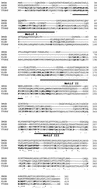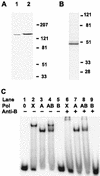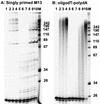The accessory subunit of Xenopus laevis mitochondrial DNA polymerase gamma increases processivity of the catalytic subunit of human DNA polymerase gamma and is related to class II aminoacyl-tRNA synthetases
- PMID: 10330144
- PMCID: PMC104363
- DOI: 10.1128/MCB.19.6.4039
The accessory subunit of Xenopus laevis mitochondrial DNA polymerase gamma increases processivity of the catalytic subunit of human DNA polymerase gamma and is related to class II aminoacyl-tRNA synthetases
Abstract
Peptide sequences obtained from the accessory subunit of Xenopus laevis mitochondrial DNA (mtDNA) polymerase gamma (pol gamma) were used to clone the cDNA encoding this protein. Amino-terminal sequencing of the mitochondrial protein indicated the presence of a 44-amino-acid mitochondrial targeting sequence, leaving a predicted mature protein with 419 amino acids and a molecular mass of 47.3 kDa. This protein is associated with the larger, catalytic subunit in preparations of active mtDNA polymerase. The small subunit exhibits homology to its human, mouse, and Drosophila counterparts. Interestingly, significant homology to glycyl-tRNA synthetases from prokaryotic organisms reveals a likely evolutionary relationship. Since attempts to produce an enzymatically active recombinant catalytic subunit of Xenopus DNA pol gamma have not been successful, we tested the effects of adding the small subunit of the Xenopus enzyme to the catalytic subunit of human DNA pol gamma purified from baculovirus-infected insect cells. These experiments provide the first functional evidence that the small subunit of DNA pol gamma stimulates processive DNA synthesis by the human catalytic subunit under physiological salt conditions.
Figures






Similar articles
-
Protein sequences conserved in prokaryotic aminoacyl-tRNA synthetases are important for the activity of the processivity factor of human mitochondrial DNA polymerase.Nucleic Acids Res. 2000 Mar 1;28(5):1237-44. doi: 10.1093/nar/28.5.1237. Nucleic Acids Res. 2000. PMID: 10666468 Free PMC article.
-
The accessory subunit of mtDNA polymerase shares structural homology with aminoacyl-tRNA synthetases: implications for a dual role as a primer recognition factor and processivity clamp.Proc Natl Acad Sci U S A. 1999 Aug 17;96(17):9527-32. doi: 10.1073/pnas.96.17.9527. Proc Natl Acad Sci U S A. 1999. PMID: 10449726 Free PMC article.
-
A novel processive mechanism for DNA synthesis revealed by structure, modeling and mutagenesis of the accessory subunit of human mitochondrial DNA polymerase.J Mol Biol. 2006 May 19;358(5):1229-43. doi: 10.1016/j.jmb.2006.02.073. Epub 2006 Mar 15. J Mol Biol. 2006. PMID: 16574152 Free PMC article.
-
DNA polymerase gamma in mitochondrial DNA replication and repair.ScientificWorldJournal. 2003 Mar 17;3:34-44. doi: 10.1100/tsw.2003.09. ScientificWorldJournal. 2003. PMID: 12806118 Free PMC article. Review.
-
DNA polymerase gamma, the mitochondrial replicase.Annu Rev Biochem. 2004;73:293-320. doi: 10.1146/annurev.biochem.72.121801.161455. Annu Rev Biochem. 2004. PMID: 15189144 Review.
Cited by
-
The EM structure of human DNA polymerase gamma reveals a localized contact between the catalytic and accessory subunits.EMBO J. 2007 Oct 3;26(19):4283-91. doi: 10.1038/sj.emboj.7601843. Epub 2007 Aug 30. EMBO J. 2007. PMID: 17762861 Free PMC article.
-
Reconstitution of a minimal mtDNA replisome in vitro.EMBO J. 2004 Jun 16;23(12):2423-9. doi: 10.1038/sj.emboj.7600257. Epub 2004 May 27. EMBO J. 2004. PMID: 15167897 Free PMC article.
-
The role of mtDNA in oocyte quality and embryo development.Mol Reprod Dev. 2023 Jul;90(7):621-633. doi: 10.1002/mrd.23640. Epub 2022 Aug 20. Mol Reprod Dev. 2023. PMID: 35986715 Free PMC article. Review.
-
Manganese superoxide dismutase is a mitochondrial fidelity protein that protects Polγ against UV-induced inactivation.Oncogene. 2012 Apr 26;31(17):2129-39. doi: 10.1038/onc.2011.407. Epub 2011 Sep 12. Oncogene. 2012. PMID: 21909133 Free PMC article.
-
Evolution of the metazoan mitochondrial replicase.Genome Biol Evol. 2015 Mar 3;7(4):943-59. doi: 10.1093/gbe/evv042. Genome Biol Evol. 2015. PMID: 25740821 Free PMC article.
References
-
- Bochkarev A, Pfuetzner R A, Edwards A M, Frappier L. Structure of the single-stranded-DNA-binding domain of replication protein A bound to DNA. Nature. 1997;385:176–181. - PubMed
-
- Curth U, Urbanke C, Greipel J, Gerberding H, Tiranti V, Zeviani M. Single-stranded-DNA-binding proteins from human mitochondria and Escherichia coli have analogous physicochemical properties. Eur J Biochem. 1994;221:435–445. - PubMed
Publication types
MeSH terms
Substances
Associated data
- Actions
Grants and funding
LinkOut - more resources
Full Text Sources
Other Literature Sources
